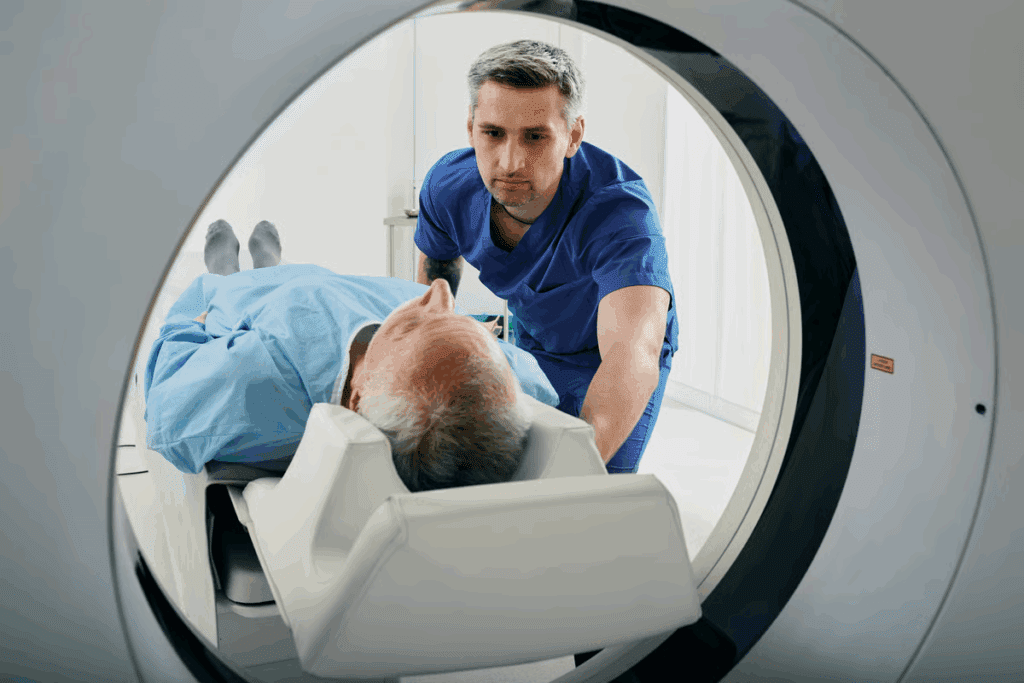Last Updated on November 26, 2025 by Bilal Hasdemir

Learn how umbilical hernia surgery is performed with a step-by-step repair guide and recovery tips.
An umbilical hernia happens when part of the intestine bulges through an opening in the abdominal muscles near the navel. If not treated, it can cause serious problems. Luckily, advanced surgical techniques can fix this issue effectively.
It’s very important to see a doctor for the right diagnosis and treatment. The surgery, called herniorrhaphy, closes the hole in the abdominal wall. This stops the bulge from getting worse. At places like Liv Hospital, patients get care tailored to their needs and expert treatment.

An umbilical hernia occurs when the abdominal wall near the navel weakens. This allows the intestines to bulge through. It can be present at birth or develop later in life.
An umbilical hernia is a bulge near the belly button. It happens when the intestine or abdominal tissue pushes through a weak spot in the muscles. This bulge is often more visible when you cough, strain, or stand up.
Several factors can lead to umbilical hernias. These include:
The main symptom of an umbilical hernia is a visible bulge near the navel. Other symptoms include:
| Symptom | Description |
| Discomfort or Pain | A feeling of discomfort or pain, often when bending over, coughing, or lifting heavy objects. |
| Nausea or Vomiting | In some cases, nausea or vomiting may occur, which can be a sign of complications. |
| Bulge or Swelling | A noticeable bulge or swelling near the belly button that may change in size. |
Seek medical help if you have severe pain, nausea, or vomiting. These could be signs of serious complications.

Deciding when to have surgery for an umbilical hernia is key. The choice depends on symptoms, risk of problems, and health. It’s a big decision.
Not every umbilical hernia needs surgery right away. For small, painless ones, watching and waiting might be best. This lets doctors keep an eye on the hernia.
Surgery is often needed for umbilical hernias that hurt, are big, or have serious problems. Symptoms like incarceration or strangulation mean big risks if not treated.
Here’s a quick guide on when surgery is usually needed:
| Indication | Description |
| Painful Hernia | Hernias causing significant discomfort or pain. |
| Large Hernia | Hernias that are significantly large or have increased in size over time. |
| Incarceration | Hernias that are trapped and cannot be pushed back into the abdomen. |
| Strangulation | Hernias with compromised blood supply, posing a risk of tissue death. |
Not fixing an umbilical hernia can cause big problems. Risks like incarceration and strangulation can lead to serious issues. These include bowel blockage and gangrene.
Knowing the dangers of not treating umbilical hernias shows why quick action is important. It’s vital for your health.
To diagnose umbilical hernias, doctors use physical exams and imaging studies. These steps help confirm the hernia’s presence and how severe it is.
A thorough physical exam is the first step in diagnosing an umbilical hernia. Doctors will look at the abdomen for a bulge or lump near the navel. They might ask the patient to cough or strain to spot the hernia.
Even with a physical exam, imaging studies might be needed to confirm the diagnosis. Ultrasound is often used because it’s non-invasive and shows real-time images. Sometimes, a CT scan or MRI is ordered for more detailed information.
After confirming the diagnosis, the next step is to choose the best surgical approach. The surgeon considers the hernia’s size, the patient’s health, and any past surgeries. They will talk to the patient about open repair and laparoscopic surgery to find the best method.
The pre-surgical evaluation also looks at the patient’s surgery risks and plans for aftercare. This detailed approach makes sure the patient is ready for surgery and recovery.
Umbilical hernia repair surgery has many methods, from open surgery to laparoscopic techniques. The choice depends on the hernia size, patient health, and surgeon’s skill.
Open repair involves a single incision near the belly button. The hernia is pushed back, and the weak spot is fixed with stitches or mesh. It’s good for small hernias and is simple and effective.
Benefits of Open Repair include a simple surgery and can be done under local anesthesia. But, it might take longer to recover than laparoscopic methods.
Laparoscopic repair uses small incisions for a laparoscope and tools. It’s quicker to recover and has less pain afterward. The surgeon uses mesh inside the belly to fix the hernia.
The advantages of laparoscopic repair include smaller scars, less infection risk, and less pain. It’s great for big hernias or those with past belly surgeries.
Umbilical herniorrhaphy fixes the hernia with sutures alone. Hernioplastia umbilical uses mesh with sutures. Both methods aim to fix the belly wall.
Umbilical herniorrhaphy works for small hernias. Hernioplastia umbilical is better for big hernias or weak tissue, as it adds extra support.
Surgical mesh is now a key part of umbilical hernia repair. It helps prevent the hernia from coming back. This is because it adds extra support to the weak area around the belly button.
Meshes for umbilical hernia repair come from synthetic materials or biological tissues. Synthetic meshes are strong and last long. Biological meshes are used when there’s a risk of infection or complications.
Synthetic Meshes: These are made from materials like polypropylene or polyester. They are durable and blend well with the body’s tissues.
Biological Meshes: These come from animal tissues or human cadavers. They are used in complex cases or when there’s a risk of infection. They help the body heal and are absorbed over time.
Mesh reinforcement is often suggested for larger hernias or those that keep coming back. The choice to use mesh depends on the hernia size, the patient’s health, and the surgeon’s opinion.
The method for placing mesh varies based on the surgery type and the surgeon’s style. Proper placement is key for success and to avoid complications.
Key Considerations: It’s important to ensure the mesh fits right and is not too big. Also, it should be placed carefully to avoid any issues.
Using mesh in umbilical hernia surgery is a big step forward. It offers a more lasting and effective fix for patients.
Getting ready for umbilical hernia surgery is key to a good outcome. It’s important to know what to do to make your recovery smooth and effective.
Before surgery, you’ll have many tests and talks to check your health. These steps help find any risks and plan the best treatment.
These steps are vital to choose the right treatment and avoid problems.
Tell your doctor about all medicines you take. This includes prescription drugs, over-the-counter meds, and supplements. Some medicines might need to be changed or stopped before surgery to avoid risks.
| Medication Type | Action Required | Timing |
| Blood Thinners (e.g., Warfarin) | Discontinue or adjust dosage | As directed by your doctor, typically 1-2 weeks before surgery |
| Antiplatelet Agents (e.g., Aspirin) | Discontinue or adjust dosage | As directed by your doctor, typically 1-2 weeks before surgery |
| Diabetes Medications | Adjust dosage | As directed by your doctor, may need to be adjusted on the day of surgery |
On surgery day, follow certain rules to make the process safe and smooth. These might include:
By following these steps, you can make sure your surgery goes well and your recovery is smooth.
The surgery to fix an umbilical hernia is very detailed. It has many important steps. These steps help fix the hernia well and lower the chance of problems.
The first thing done is giving anesthesia. Anesthesia is key for keeping the patient comfortable during the surgery. The kind of anesthesia used can be local, sedation, or general, depending on the surgery’s complexity and what the patient wants.
After the anesthesia, the surgeon cuts near the belly button. The size and type of cut depend on the hernia’s size and the surgery method. For example, open repair uses one big cut, while laparoscopic repair uses several small ones.
Then, the surgeon pushes the hernia back into the belly. Fixing the belly wall comes next. This might mean stitching the area or putting in a mesh. The choice depends on the hernia’s size and the patient’s health.
After fixing the hernia and belly wall, the surgeon closes the cut. The way the cut is closed can be with stitches, staples, or dissolvable stitches. The aim is to close it well to help healing and avoid problems.
Knowing these steps helps patients understand the detailed and careful work of umbilical hernia surgery.
Recovering from umbilical hernia surgery involves managing pain, avoiding certain activities, and taking care of the wound. A smooth recovery is key to the surgery’s success.
The first hours after surgery are very important. Patients stay in a recovery room to watch for any problems and check their health.
Key aspects to monitor during this period include:
Managing pain is a big part of recovery. There are several ways to do this, including:
It’s important to avoid certain activities to prevent problems and help the body heal. How soon you can start doing things again depends on your health and the surgery.
A general guideline includes:
Good wound care is key to avoiding infection and helping it heal. Patients need to follow a care plan given by their doctor.
Follow-up appointments are important for:
Umbilical hernia repair is a very effective surgery. It has great long-term results and success rates. Studies show that the chance of the hernia coming back is low. This means the surgery works well most of the time.
The success of this surgery comes from better techniques and using mesh. Knowing how the surgery is done helps us see its benefits. It not only relieves symptoms but also lowers the risk of serious problems from untreated hernias.
People who have this surgery usually heal quickly. They can get back to their usual activities in just a few weeks. The long-term results are usually good, with most people not having any more problems with the hernia. So, umbilical hernia repair is a safe and effective way to treat hernias.
An umbilical hernia happens when part of the intestine bulges through a weak spot in the abdominal muscles near the navel.
You might see a bulge or lump near the belly button. You could also feel pain or discomfort, mostly when you cough, strain, or lift heavy things.
Doctors usually diagnose it by feeling the area. They might also use an ultrasound or CT scan to confirm it.
If left untreated, umbilical hernias can get worse. They might become trapped or cut off from blood supply, leading to serious problems.
Open repair uses one big incision near the hernia. Laparoscopic repair uses small incisions and a camera to guide the surgery.
Mesh reinforcement uses a synthetic or biologic mesh to support the weak area. It helps prevent the hernia from coming back.
Recovery time varies. Most people can get back to normal in a few weeks. But, it can take several months to fully recover.
Laparoscopic repair has many benefits. It uses smaller incisions, causes less pain, and lets you get back to normal activities faster.
Yes, hernias can come back. But, using mesh reinforcement and proper surgical techniques can lower the risk.
To prepare, you’ll have pre-surgery consultations and medication management. Follow the day-of-surgery instructions to make the process smooth and successful.
Khalil, H. M., et al. (2021). Biliary leakage following cholecystectomy: A prospective population study. Journal of Research in Medical and Dental Science, 9(5), 289-296. Retrieved from https://www.jrmds.in/articles/biliary-leakage-following-cholecystectomy-a-prospective-population-study-84919.html
Subscribe to our e-newsletter to stay informed about the latest innovations in the world of health and exclusive offers!